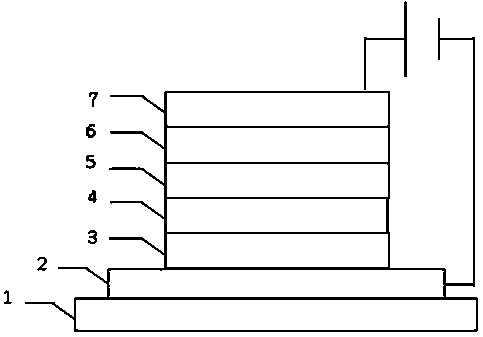Quantum dot light-emitting diode and preparation method thereof
A quantum dot light-emitting and diode technology, which is used in the manufacture of semiconductor/solid-state devices, electrical components, and electrical solid-state devices to achieve the effects of improving luminous efficiency, promoting transmission, and improving performance
- Summary
- Abstract
- Description
- Claims
- Application Information
AI Technical Summary
Problems solved by technology
Method used
Image
Examples
Embodiment 1
[0053] Embodiment 1: The following uses titanium acetate, ethanol, sodium hydroxide, PFN, and ethanol as examples for detailed introduction.
[0054] Add appropriate amount of titanium acetate to 50ml ethanol to form a concentration of 0.5M titanium acetate solution, at 70 o Stir to dissolve at C; dissolve sodium hydroxide in 10ml ethanol to form a sodium hydroxide solution, add sodium hydroxide solution to the titanium acetate solution (the molar ratio of sodium hydroxide to titanium ions is 4:1, pH=12), Continue stirring at 70°C for 4 h to form Ti(OH) 4 solution.
[0055] Subsequently, an appropriate amount of PFN was dissolved in ethanol to form a 1.5 mg / ml PFN solution.
[0056] Finally, on the treated substrate, Ti(OH) 4 The solution was spin-coated with a coater and heated at 250 o C annealed to form TiO 2 layer; and drop the PFN solution onto the TiO 2 layer, and at 100 o C annealed to form a film to form TiO 2 layer / PFN layer stack structure.
Embodiment 2
[0057] Embodiment 2: The following takes titanium nitrate, methanol, potassium hydroxide, PFN, and methanol as examples for detailed introduction.
[0058] An appropriate amount of titanium nitrate was added to 50ml of methanol to form a concentration of 0.5M titanium nitrate solution, at 60 o Stir and dissolve under C; dissolve potassium hydroxide in 10ml methanol to form sodium hydroxide solution, add sodium hydroxide solution to titanium nitrate solution (the molar ratio of potassium hydroxide to titanium ions is 4:1, pH=12), Continue stirring at 60°C for 4h to form Ti(OH) 4 solution.
[0059] Subsequently, an appropriate amount of PFN was dissolved in methanol to form a 1.5 mg / ml PFN solution.
[0060] Finally, on the treated substrate, Ti(OH) 4 The solution was spin-coated with a coater and heated at 250 o C annealed to form TiO 2 layer; and drop the PFN solution onto the TiO 2 layer, and at 100 o C annealed to form a film to form TiO 2 layer / PFN layer stack struc...
Embodiment 3
[0061] Embodiment 3: The following uses titanium chloride, propanol, lithium hydroxide, PFN, and propanol as examples for detailed introduction.
[0062] Add an appropriate amount of titanium chloride to 50 ml of propanol to form a titanium chloride solution with a concentration of 0.5 M, at 80 o C under stirring to dissolve. Dissolve lithium hydroxide in 10 ml propanol to form a lithium hydroxide solution, add lithium hydroxide solution to the titanium chloride solution (the molar ratio of lithium hydroxide to titanium ions is 4:1, pH=12), and continue to Stir at 80°C for 4 h to form Ti(OH) 4 solution.
[0063] Subsequently, an appropriate amount of PFN was dissolved in propanol to form a 1.5 mg / ml PFN solution.
[0064] Finally, on the treated substrate, Ti(OH) 4 The solution was spin-coated with a coater and heated at 250 oC annealed to form TiO 2 layer; and drop the PFN solution onto the TiO 2 layer, and at 100 oC Annealed to form a film to form TiO 2 layer / PFN la...
PUM
| Property | Measurement | Unit |
|---|---|---|
| thickness | aaaaa | aaaaa |
| thickness | aaaaa | aaaaa |
| concentration | aaaaa | aaaaa |
Abstract
Description
Claims
Application Information
 Login to View More
Login to View More - R&D
- Intellectual Property
- Life Sciences
- Materials
- Tech Scout
- Unparalleled Data Quality
- Higher Quality Content
- 60% Fewer Hallucinations
Browse by: Latest US Patents, China's latest patents, Technical Efficacy Thesaurus, Application Domain, Technology Topic, Popular Technical Reports.
© 2025 PatSnap. All rights reserved.Legal|Privacy policy|Modern Slavery Act Transparency Statement|Sitemap|About US| Contact US: help@patsnap.com

